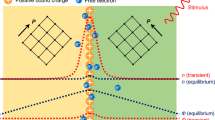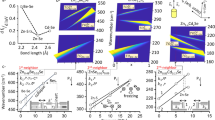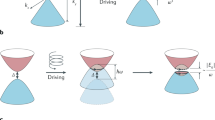Abstract
Material systems that reside far from thermodynamic equilibrium have the potential to exhibit dynamic properties and behaviours resembling those of living organisms. Here we realize a non-equilibrium material characterized by a bandgap whose edge is enslaved to the wavelength of an external coherent drive. The structure dynamically self-assembles into an unconventional pseudo-crystal geometry that equally distributes momentum across elements. The emergent bandgap is bestowed with lifelike properties, such as the ability to self-heal to perturbations and adapt to sudden changes in the drive. We derive an exact analytical solution for both the spatial organization and the bandgap features, revealing the mechanism for enslavement. This work presents a framework for conceiving lifelike non-equilibrium materials and emphasizes the potential for the dynamic imprinting of material properties through external degrees of freedom.
This is a preview of subscription content, access via your institution
Access options
Access Nature and 54 other Nature Portfolio journals
Get Nature+, our best-value online-access subscription
$29.99 / 30 days
cancel any time
Subscribe to this journal
Receive 12 print issues and online access
$259.00 per year
only $21.58 per issue
Buy this article
- Purchase on Springer Link
- Instant access to full article PDF
Prices may be subject to local taxes which are calculated during checkout




Similar content being viewed by others
References
Bhat, H. L. Introduction to Crystal Growth: Principles and Practice (CRC Press, 2014).
Kalsin, A. M. et al. Electrostatic self-assembly of binary nanoparticle crystals with a diamond-like lattice. Science 312, 420–424 (2006).
Dong, A., Chen, J., Vora, P. M., Kikkawa, J. M. & Murray, C. B. Binary nanocrystal superlattice membranes self-assembled at the liquid–air interface. Nature 466, 474–477 (2010).
van Blaaderen, A., Ruel, R. & Wiltzius, P. Template-directed colloidal crystallization. Nature 385, 321–324 (1997).
Leunissen, M. E. et al. Ionic colloidal crystals of oppositely charged particles. Nature 437, 235–240 (2005).
de Nijs, B. et al. Entropy-driven formation of large icosahedral colloidal clusters by spherical confinement. Nat. Mater. 14, 56–60 (2014).
Grzybowski, B. A., Wilmer, C. E., Kim, J., Browne, K. P. & Bishop, K. J. M. Self-assembly: from crystals to cells. Soft Matter 5, 1110–1128 (2009).
Karsenti, E. Self-organization in cell biology: a brief history. Nat. Rev. Mol. Cell Biol. 9, 255–262 (2008).
Shimoyama, N., Sugawara, K., Mizuguchi, T., Hayakawa, Y. & Sano, M. Collective motion in a system of motile elements. Phys. Rev. Lett. 76, 3870–3873 (1996).
Couzin, I. D. & Franks, N. R. Self-organized lane formation and optimized traffic flow in army ants. Proc. R. Soc. B 270, 139–146 (2003).
Mateus, A. M., Gorfinkiel, N. & Arias, A. M. Origin and function of fluctuations in cell behaviour and the emergence of patterns. Semin. Cell Dev. Biol. 20, 877–884 (2009).
Mora, T. et al. Local equilibrium in bird flocks. Nat. Phys. 12, 1153–1157 (2016).
Whitesides, G. M. & Grzybowski, B. Self-assembly at all scales. Science 295, 2418–2421 (2002).
Kondepudi, D. & Prigogine, I. Modern Thermodynamics: From Heat Engines to Dissipative Structures (John Wiley, 2014).
Fialkowski, M. et al. Principles and implementations of dissipative (dynamic) self-assembly. J. Phys. Chem. B 110, 2482–2496 (2006).
Osterman, N. et al. Field-induced self-assembly of suspended colloidal membranes. Phys. Rev. Lett. 103, 228301 (2009).
Grzybowski, B. A., Stone, H. A. & Whitesides, G. M. Dynamic self-assembly of magnetized, millimetre-sized objects rotating at a liquid–air interface. Nature 405, 1033–1036 (2000).
Snezhko, A., Aranson, I. S. & Kwok, W.-K. Surface wave assisted self-assembly of multidomain magnetic structures. Phys. Rev. Lett. 96, 078701 (2006).
Snezhko, A. & Aranson, I. S. Magnetic manipulation of self-assembled colloidal asters. Nat. Mater. 10, 698–703 (2011).
Lehn, J.-M. Toward self-organization and complex matter. Science 295, 2400–2403 (2002).
England, J. L. Dissipative adaptation in driven self-assembly. Nat. Nanotech. 10, 919–923 (2015).
Perunov, N., Marsland, R. A. & England, J. L. Statistical physics of adaptation. Phys. Rev. X 6, 021036 (2016).
Snezhko, A., Belkin, M., Aranson, I. S. & Kwok, W.-K. Self-assembled magnetic surface swimmers. Phys. Rev. Lett. 102, 118103 (2009).
Boekhoven, J. et al. Dissipative self-assembly of a molecular gelator by using a chemical fuel. Angew. Chem. 122, 4935–4938 (2010).
Bricard, A., Caussin, J.-B., Desreumaux, N., Dauchot, O. & Bartolo, D. Emergence of macroscopic directed motion in populations of motile colloids. Nature 503, 95–98 (2013).
Palacci, J., Sacanna, S., Steinberg, A. P., Pine, D. J. & Chaikin, P. M. Living crystals of light-activated colloidal surfers. Science 339, 936–940 (2013).
Martinez-Pedrero, F., Ortiz-Ambriz, A., Pagonabarraga, I. & Tierno, P. Colloidal microworms propelling via a cooperative hydrodynamic conveyor belt. Phys. Rev. Lett. 115, 138301 (2015).
Solis, K. J. & Martin, J. E. Complex magnetic fields breathe life into fluids. Soft Matter 10, 9136–9142 (2014).
Maiti, S., Fortunati, I., Ferrante, C., Scrimin, P. & Prins, L. J. Dissipative self-assembly of vesicular nanoreactors. Nat. Chem. 8, 725–731 (2016).
Vlasov, Y. A., Bo, X.-Z., Sturm, J. C. & Norris, D. J. On-chip natural assembly of silicon photonic bandgap crystals. Nature 414, 289–293 (2001).
Hynninen, A.-P., Thijssen, J. H. J., Vermolen, E. C. M., Dijkstra, M. & van Blaaderen, A. Self-assembly route for photonic crystals with a bandgap in the visible region. Nat. Mater. 6, 202–205 (2007).
Lemoult, F., Kaina, N., Fink, M. & Lerosey, G. Wave propagation control at the deep subwavelength scale in metamaterials. Nat. Phys. 9, 55–60 (2012).
Alonso-Redondo, E. et al. A new class of tunable hypersonic phononic crystals based on polymer-tethered colloids. Nat. Commun. 6, 8309 (2015).
Beatus, T., Tlusty, T. & Bar-Ziv, R. Phonons in a one-dimensional microfluidic crystal. Nat. Phys. 2, 743–748 (2006).
Timonen, J. V. I., Latikka, M., Leibler, L., Ras, R. H. A. & Ikkala, O. Switchable static and dynamic self-assembly of magnetic droplets on superhydrophobic surfaces. Science 341, 253–257 (2013).
Tretiakov, K. V., Bishop, K. J. M. & Grzybowski, B. A. The dependence between forces and dissipation rates mediating dynamic self-assembly. Soft Matter 5, 1279–1284 (2009).
Joannopoulos, J. D., Johnson, S. G., Winn, J. N. & Meade, R. D. Photonic Crystals: Molding the Flow of Light 2nd edn (Princeton Univ. Press, 2011).
Dholakia, K. & Zemánek, P. Gripped by light: optical binding. Rev. Mod. Phys. 82, 1767–1791 (2010).
Karásek, V. et al. Long-range one-dimensional longitudinal optical binding. Phys. Rev. Lett. 101, 143601 (2008).
Frawley, M. C., Gusachenko, I., Truong, V. G., Sergides, M. & Chormaic, S. N. Selective particle trapping and optical binding in the evanescent field of an optical nanofiber. Opt. Express 22, 16322–16334 (2014).
Strogatz, S. H. Nonlinear Dynamics And Chaos: With Applications To Physics, Biology, Chemistry, And Engineering (Westview Press, 2001).
von Freymann, G., Kitaev, V., Lotsch, B. V. & Ozin, G. A. Bottom-up assembly of photonic crystals. Chem. Soc. Rev. 42, 2528–2554 (2013).
Prather, D. W. Photonic Crystals, Theory, Applications and Fabrication (John Wiley, 2009).
Martyushev, L. M. & Seleznev, V. D. Maximum entropy production principle in physics, chemistry and biology. Phys. Rep. 426, 1–45 (2006).
Ross, J., Corlan, A. D. & Müller, S. C. Proposed principles of maximum local entropy production. J. Phys. Chem. B 116, 7858–7865 (2012).
Martyushev, L. M. & Seleznev, V. D. The restrictions of the maximum entropy production principle. Phys. Stat. Mech. Appl. 410, 17–21 (2014).
Deplazes, A. & Huppenbauer, M. Synthetic organisms and living machines. Syst. Synth. Biol. 3, 55–63 (2009).
Deplazes, A. Piecing together a puzzle. EMBO Rep. 10, 428–432 (2009).
Szostak, J. W., Bartel, D. P. & Luisi, P. L. Synthesizing life. Nature 409, 387–390 (2001).
Haken, H. Principles of Brain Functioning: A Synergetic Approach to Brain Activity, Behavior and Cognition (Springer Science & Business Media, 2013).
Acknowledgements
The experimental part of this work is supported by the Office of Naval Research (ONR) MURI program under Grant No. N00014-13-1-0631; the numerical calculation and energy analysis is supported by the ‘Light-Material Interactions in Energy Conversion’ Energy Frontier Research Center funded by the US Department of Energy, Office of Science, Office of Basic Energy Sciences under Award Number DE-AC02-05CH11231.
Author information
Authors and Affiliations
Contributions
N.B. and C.R. designed and conducted experiments and performed the theoretical investigation; M.D. performed COMSOL simulations; R.Z. provided theoretical guidance; X.Z. and Y.W. guided the research. All authors contributed to writing the manuscript.
Corresponding author
Ethics declarations
Competing interests
The authors declare no competing financial interests.
Supplementary information
Supplementary Information
Supplementary Information (PDF 1190 kb)
Supplementary Information
Supplementary Movie 1 (AVI 49552 kb)
Supplementary Information
Supplementary Movie 2 (AVI 25284 kb)
Supplementary Information
Supplementary Movie 3 (AVI 42756 kb)
Rights and permissions
About this article
Cite this article
Bachelard, N., Ropp, C., Dubois, M. et al. Emergence of an enslaved phononic bandgap in a non-equilibrium pseudo-crystal. Nature Mater 16, 808–813 (2017). https://doi.org/10.1038/nmat4920
Received:
Accepted:
Published:
Issue Date:
DOI: https://doi.org/10.1038/nmat4920
This article is cited by
-
Self-organized lasers from reconfigurable colloidal assemblies
Nature Physics (2022)
-
Emergence of energy-avoiding and energy-seeking behaviors in nonequilibrium dissipative quantum systems
Communications Physics (2022)
-
Double defects-induced elastic wave coupling and energy localization in a phononic crystal
Nano Convergence (2021)
-
Self-replication of a quantum artificial organism driven by single-photon pulses
Scientific Reports (2021)
-
Partitioned gradient-index phononic crystals for full phase control
Scientific Reports (2020)



